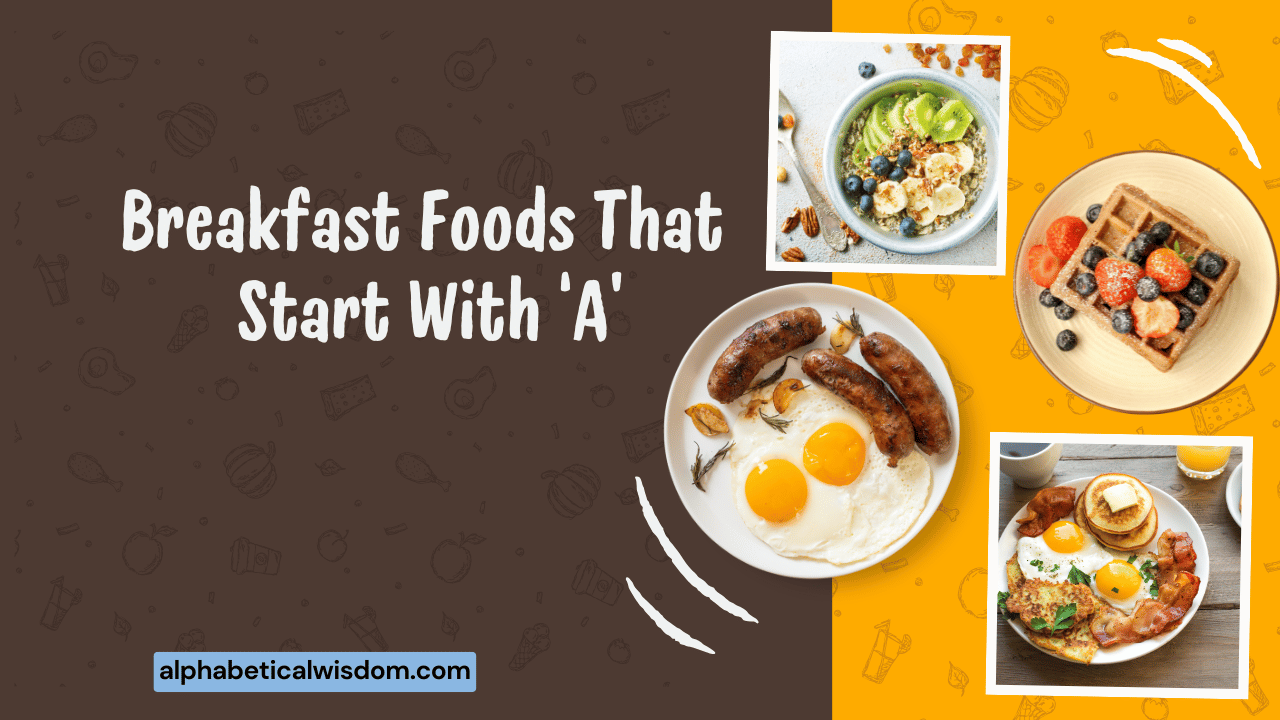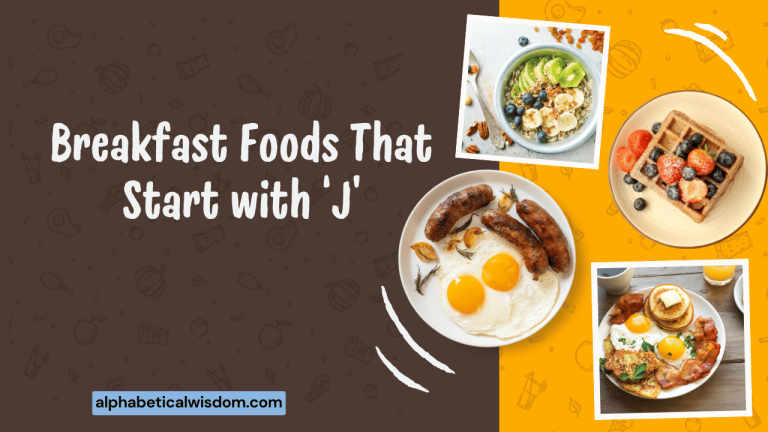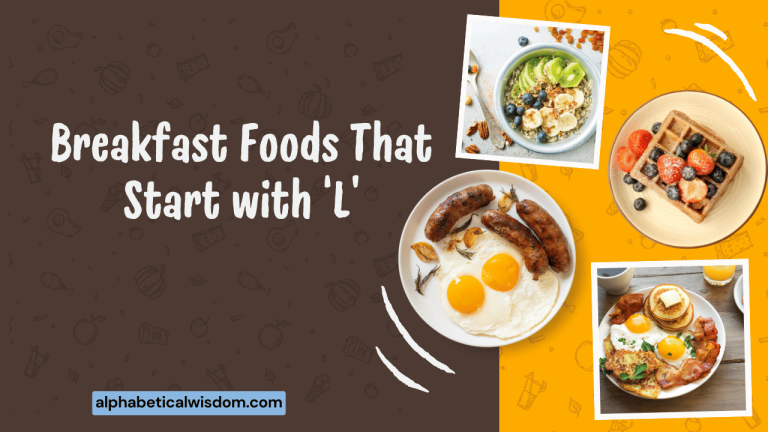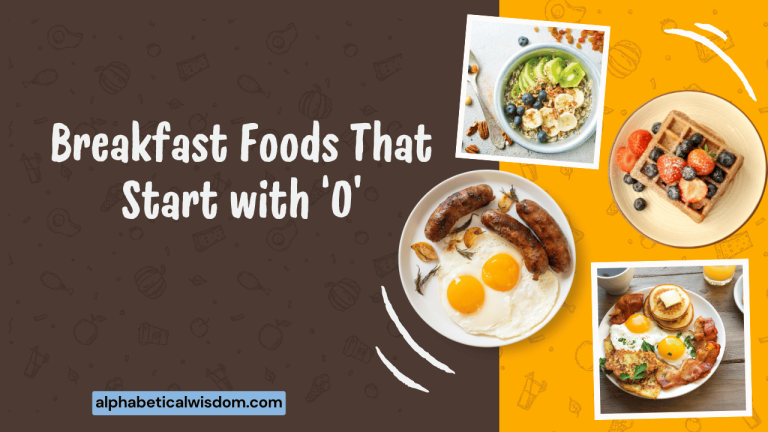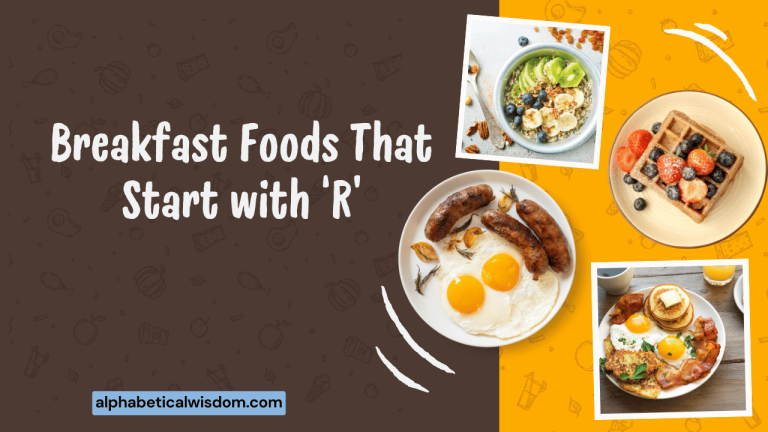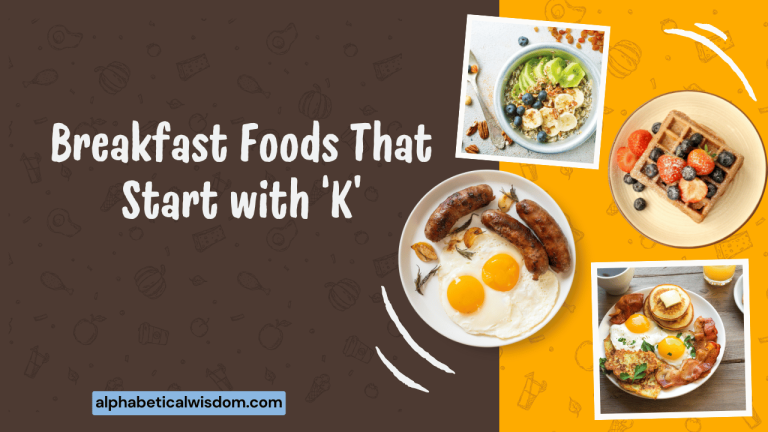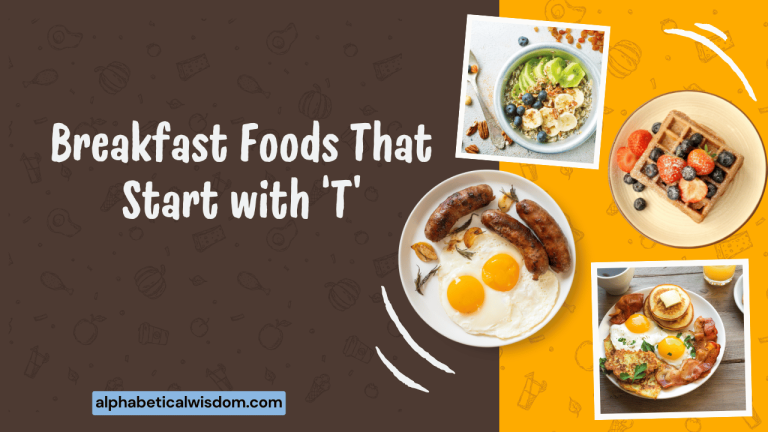Breakfast Foods That Start With A: A Grammatical Guide
Breakfast, the most important meal of the day, often features a delightful array of foods. But have you ever considered how these foods, particularly those starting with the letter “A,” interact with English grammar?
This article delves into the grammatical aspects of breakfast foods beginning with “A,” providing a comprehensive guide for English language learners and enthusiasts. Understanding how to correctly use these terms in sentences will enhance your vocabulary and improve your overall command of the English language.
Whether you’re a beginner or an advanced learner, this exploration offers valuable insights into the nuances of grammar in a culinary context.
Table of Contents
- Introduction
- Definition of Breakfast Foods Starting With “A”
- Structural Breakdown: Nouns and Articles
- Types and Categories of “A” Breakfast Foods
- Examples of “A” Breakfast Foods in Sentences
- Usage Rules for “A” Breakfast Foods
- Common Mistakes and Corrections
- Practice Exercises
- Advanced Topics
- Frequently Asked Questions
- Conclusion
Definition of Breakfast Foods Starting With “A”
Breakfast foods starting with the letter “A” encompass a variety of items typically consumed during the morning meal. These can include fruits, baked goods, and other dishes that provide nourishment and energy to start the day. Grammatically, these foods function primarily as nouns, representing tangible items that can be either countable or uncountable, singular or plural. Understanding their grammatical properties is crucial for constructing accurate and meaningful sentences.
The classification of these foods can vary based on their origin and preparation. For instance, an apple is a fruit, while an almond croissant is a baked good.
The context in which these foods are used dictates their grammatical role in a sentence. A simple sentence might be, “I ate an apple,” where “apple” is a singular, countable noun.
Conversely, in “I added almonds to my cereal,” “almonds” is a plural, countable noun. The correct usage depends on the specific food and the intended meaning.
Structural Breakdown: Nouns and Articles
The structural breakdown of sentences involving breakfast foods starting with “A” primarily focuses on the use of nouns and articles. Nouns, as mentioned earlier, are the core components representing the food items.
Articles, such as “a,” “an,” and “the,” are determiners that specify whether a noun is general or specific. The correct article usage depends on whether the noun is singular, plural, countable, or uncountable, and whether it is being introduced for the first time or has already been mentioned.
For example, when referring to a single, unspecified item, we use “a” or “an.” The choice between “a” and “an” depends on the sound of the word that follows. “An” is used before words that start with a vowel sound, while “a” is used before words that start with a consonant sound. Consider these examples: “I want an apple” (vowel sound) versus “I had a croissant” (consonant sound). The article “the” is used when referring to a specific item that has already been mentioned or is known to both the speaker and the listener. For instance, “The apple I ate was delicious.”
Types and Categories of “A” Breakfast Foods
Breakfast foods that begin with the letter “A” can be categorized into several groups based on their nature and preparation. These categories provide a structured way to understand and classify these foods, which aids in their grammatical usage.
Fruits
Fruits are a common and healthy breakfast option. They are typically sweet and can be eaten raw or used in various recipes.
Common examples include apples, apricots, avocados, and Asian pears. Grammatically, fruits can be both countable and uncountable depending on the context.
For instance, “I ate an apple” (countable) versus “I like apple juice” (uncountable).
Baked Goods
Baked goods often provide a more indulgent breakfast. These include items like almond croissants, apple turnovers, and Anadama bread.
Baked goods are generally countable, especially when referring to individual items. For example, “I had an almond croissant for breakfast” (countable).
Other “A” Breakfast Foods
This category includes other breakfast items that don’t neatly fit into the fruits or baked goods categories. Examples include almond milk, açai bowls, and avocado toast.
These items can be either countable or uncountable depending on the specific food. For example, “I drank almond milk” (uncountable) versus “I ordered an açai bowl” (countable).
Examples of “A” Breakfast Foods in Sentences
Understanding how “A” breakfast foods are used in sentences is crucial for mastering their grammatical usage. The following examples demonstrate different sentence structures and grammatical contexts.
Countable vs. Uncountable Nouns
Countable nouns can be counted and have a plural form, while uncountable nouns cannot be counted and do not have a plural form. Here are examples illustrating the difference:
The table below illustrates the use of countable and uncountable nouns with “A” breakfast foods.
| Countable Noun | Example Sentence | Uncountable Noun | Example Sentence |
|---|---|---|---|
| An apple | I ate an apple this morning. | Apple juice | I drank apple juice with my breakfast. |
| An apricot | She picked an apricot from the tree. | Apricot jam | He spread apricot jam on his toast. |
| An avocado | He sliced an avocado for his toast. | Avocado oil | She used avocado oil in her salad dressing. |
| An almond croissant | I bought an almond croissant from the bakery. | Almond flour | She used almond flour to bake the cake. |
| An Asian pear | She sliced an Asian pear for a snack. | ||
| An açai bowl | I ordered an açai bowl for breakfast. | ||
| An arepa | He ate an arepa with cheese. | ||
| An artichoke | She grilled an artichoke for dinner. | ||
| An ambrosia salad | They served an ambrosia salad at the picnic. | ||
| An apple fritter | I enjoyed an apple fritter with my coffee. | ||
| An apple pie | She baked an apple pie for dessert. | ||
| An arequipe | He spread an arequipe on his bread. | ||
| An arugula salad | She made an arugula salad for lunch. | ||
| An apple crumble | I baked an apple crumble for dessert. | ||
| An apple strudel | She enjoyed an apple strudel with tea. | ||
| An arequipe crepe | He ordered an arequipe crepe at the cafe. | ||
| An artichoke dip | She prepared an artichoke dip for the party. | ||
| An arugula pesto | He added an arugula pesto to the pasta. | ||
| An apple tart | I bought an apple tart from the bakery. | ||
| An avocado smoothie | She made an avocado smoothie for breakfast. | ||
| An artichoke heart | He included an artichoke heart in the salad. | ||
| An almond biscotti | I dipped an almond biscotti in my coffee. | ||
| An asiago cheese | She grated an asiago cheese on the pasta. | ||
| An abelskiver | They served an abelskiver at the Christmas market. | ||
| An adzuki bean | She cooked an adzuki bean for the soup. | ||
| An apple butter | He spread an apple butter on his toast. | ||
| An apricot bread | I baked an apricot bread for the picnic. | ||
| An arancini | She made an arancini for the appetizer. |
Plural vs. Singular Nouns
Singular nouns refer to one item, while plural nouns refer to more than one. The following examples show how “A” breakfast foods are used in both singular and plural forms.
The table below shows examples of singular and plural nouns in sentences.
| Singular Noun | Example Sentence | Plural Noun | Example Sentence |
|---|---|---|---|
| An apple | I want to eat an apple. | Apples | We bought several apples at the market. |
| An apricot | She offered me an apricot. | Apricots | These apricots are very sweet. |
| An avocado | He added an avocado to his salad. | Avocados | Avocados are a good source of healthy fats. |
| An almond croissant | I ordered an almond croissant at the bakery. | Almond croissants | They sell delicious almond croissants here. |
| An Asian pear | She sliced an Asian pear for her lunch. | Asian pears | Asian pears are crisp and juicy. |
| An açai bowl | He enjoyed an açai bowl after his workout. | Açai bowls | Açai bowls are a popular breakfast option. |
| An arepa | She cooked an arepa for breakfast. | Arepas | Arepas are a traditional South American dish. |
| An artichoke | He grilled an artichoke for dinner. | Artichokes | Artichokes are a healthy vegetable. |
| An ambrosia salad | She made an ambrosia salad for the potluck. | Ambrosia salads | Ambrosia salads are a classic dessert. |
| An apple fritter | He ate an apple fritter with his coffee. | Apple fritters | Apple fritters are a sweet treat. |
| An apple pie | She baked an apple pie for Thanksgiving. | Apple pies | Apple pies are a popular dessert. |
| An arequipe | He spread an arequipe on his toast. | Arequipes | Arequipes are a sweet caramel spread. |
| An arugula salad | She ordered an arugula salad for lunch. | Arugula salads | Arugula salads are a healthy option. |
| An apple crumble | I baked an apple crumble for dessert. | Apple crumbles | Apple crumbles are easy to make. |
| An apple strudel | She ate an apple strudel with tea. | Apple strudels | Apple strudels are a delicious pastry. |
| An arequipe crepe | He ordered an arequipe crepe at the cafe. | Arequipe crepes | Arequipe crepes are a sweet treat. |
| An artichoke dip | She brought an artichoke dip to the party. | Artichoke dips | Artichoke dips are a popular appetizer. |
| An arugula pesto | He made an arugula pesto for the pasta. | Arugula pestos | Arugula pestos have a unique flavor. |
| An apple tart | I bought an apple tart from the bakery. | Apple tarts | Apple tarts are a classic dessert. |
| An avocado smoothie | She made an avocado smoothie for breakfast. | Avocado smoothies | Avocado smoothies are a healthy option. |
| An artichoke heart | He added an artichoke heart to the salad. | Artichoke hearts | Artichoke hearts are a delicious addition. |
| An almond biscotti | I dipped an almond biscotti in my coffee. | Almond biscotti | Almond biscotti are a perfect snack. |
| An asiago cheese | She grated an asiago cheese on the pasta. | Asiago cheeses | Asiago cheeses come in different varieties. |
| An abelskiver | They served an abelskiver at the market. | Abelskivers | Abelskivers are a traditional Danish treat. |
| An adzuki bean | She cooked an adzuki bean for the soup. | Adzuki beans | Adzuki beans are used in Asian cuisine. |
| An apple butter | He spread an apple butter on his toast. | Apple butters | Apple butters are a delicious spread. |
| An apricot bread | I baked an apricot bread for the picnic. | Apricot breads | Apricot breads are a sweet treat. |
| An arancini | She made an arancini for the appetizer. | Arancini | Arancini are a popular Italian snack. |
Descriptive Sentences
Descriptive sentences provide more information about the “A” breakfast foods, using adjectives and other descriptive words. These sentences help to create a vivid picture and enhance understanding.
The table below presents descriptive sentences using “A” breakfast foods.
| Breakfast Food | Descriptive Sentence |
|---|---|
| Apple | The crisp apple was a refreshing start to the day. |
| Apricot | The juicy apricot had a sweet and tangy flavor. |
| Avocado | The creamy avocado made the toast delicious and nutritious. |
| Almond croissant | The flaky almond croissant was filled with a sweet almond paste. |
| Asian pear | The crunchy Asian pear was sweet and slightly tart. |
| Açai bowl | The vibrant açai bowl was topped with fresh fruit and crunchy granola. |
| Arepa | The warm arepa was stuffed with savory cheese. |
| Artichoke | The tender artichoke was grilled to perfection. |
| Ambrosia salad | The colorful ambrosia salad was a sweet and creamy treat. |
| Apple fritter | The golden apple fritter was crispy on the outside and soft on the inside. |
| Apple pie | The homemade apple pie had a flaky crust and a spiced filling. |
| Arequipe | The rich arequipe was drizzled over the pancakes. |
| Arugula salad | The peppery arugula salad was dressed with a light vinaigrette. |
| Apple crumble | The warm apple crumble was topped with a buttery and crisp topping. |
| Apple strudel | The delicate apple strudel was filled with sweet apples and raisins. |
| Arequipe crepe | The thin arequipe crepe was filled with sweet caramel. |
| Artichoke dip | The creamy artichoke dip was served with crispy crackers. |
| Arugula pesto | The fresh arugula pesto was mixed with pasta. |
| Apple tart | The mini apple tart had a buttery crust and a sweet filling. |
| Avocado smoothie | The green avocado smoothie was creamy and refreshing. |
| Artichoke heart | The tender artichoke heart was marinated in olive oil. |
| Almond biscotti | The crunchy almond biscotti was perfect with coffee. |
| Asiago cheese | The sharp asiago cheese was grated over the pasta. |
| Abelskiver | The puffy abelskiver was dusted with powdered sugar. |
| Adzuki bean | The small adzuki bean was cooked in the soup. |
| Apple butter | The smooth apple butter was spread on the toast. |
| Apricot bread | The sweet apricot bread was perfect for breakfast. |
| Arancini | The fried arancini was filled with rice and cheese. |
Usage Rules for “A” Breakfast Foods
Proper usage of “A” breakfast foods in sentences involves understanding and applying specific grammatical rules. These rules govern the use of articles, quantifiers, and prepositions.
Using Articles (a, an, the)
The articles “a,” “an,” and “the” are essential for specifying whether a noun is general or specific. “A” and “an” are indefinite articles used when referring to a non-specific item, while “the” is a definite article used when referring to a specific item.
Consider the following rules:
- Use “a” before words that start with a consonant sound: “a croissant,” “a pear.”
- Use “an” before words that start with a vowel sound: “an apple,” “an apricot.”
- Use “the” when referring to a specific item: “The apple I ate was delicious.”
Using Quantifiers (some, any, much, many)
Quantifiers are used to indicate the quantity of a noun. “Some” and “any” are used for both countable and uncountable nouns, while “much” is used for uncountable nouns and “many” is used for countable nouns.
Examples:
- “I want some apple juice.” (uncountable)
- “Do you have any apricots?” (countable)
- “I don’t have much almond milk left.” (uncountable)
- “How many apples did you buy?” (countable)
Using Prepositions (with, of, in, on)
Prepositions are used to show the relationship between nouns and other words in the sentence. Common prepositions used with “A” breakfast foods include “with,” “of,” “in,” and “on.”
Examples:
- “I had toast with avocado.”
- “This is a slice of apple pie.”
- “There are almonds in the croissant.”
- “I spread jam on my toast.”
Common Mistakes and Corrections
Even experienced English speakers sometimes make mistakes when using “A” breakfast foods in sentences. Here are some common errors and their corrections:
The table below shows common mistakes and their corrections.
| Incorrect | Correct | Explanation |
|---|---|---|
| I want a apple. | I want an apple. | “Apple” starts with a vowel sound, so use “an.” |
| I like apple. | I like apples. | “Apple” should be plural to refer to apples in general. |
| I ate a almond. | I ate an almond. | “Almond” starts with a vowel sound (when pronounced with a leading vowel sound), so use “an.” |
| I want much apples. | I want many apples. | “Apples” is countable, so use “many.” |
| I don’t have some apricots. | I don’t have any apricots. | Use “any” in negative sentences and questions. |
| The avocado are ripe. | The avocado is ripe. | “Avocado” is singular, so use “is.” |
| I like a almond croissant. | I like almond croissants. | To refer to almond croissants in general, use the plural form. |
| I eat apple juice every morning. | I drink apple juice every morning. | “Drink” is the appropriate verb for liquids like juice. |
| She has a apricots. | She has some apricots. | “Apricots” is plural and countable, so use “some.” |
| I want a avocado. | I want an avocado. | “Avocado” starts with a vowel sound, so use “an.” |
| I don’t like much avocados. | I don’t like many avocados. | “Avocados” is countable, so use “many” in negative sentences. |
| The almond croissant are delicious. | The almond croissants are delicious. | With multiple croissants, the noun and verb should be plural. |
| I ate a açai bowl. | I ate an açai bowl. | “Açai” starts with a vowel sound, so use “an.” |
| I like the apples. | I like apples. | In this context, the article “the” is unnecessary. |
| I want a arepa. | I want an arepa. | “Arepa” starts with a vowel sound, so use “an.” |
| I don’t like some artichokes. | I don’t like any artichokes. | “Any” is more appropriate in negative statements. |
| She made the ambrosia salad. | She made an ambrosia salad. | Here, “an” is more appropriate as it’s not a specific salad. |
| I ate a apple fritters. | I ate some apple fritters. | “Fritters” is plural, so use “some.” |
| The apple pie are delicious. | The apple pie is delicious. | “Pie” is singular, so use “is.” |
Practice Exercises
Test your understanding with these practice exercises. Choose the correct word or phrase to complete each sentence.
The following table includes practice exercises to test your knowledge.
| Question | Answer |
|---|---|
| 1. I want to eat ______ apple. (a/an/the) | an |
| 2. She has ______ apricots in her basket. (some/any/much) | some |
| 3. I don’t have ______ almond milk left. (much/many/some) | much |
| 4. How ______ apples did you buy? (much/many/any) | many |
| 5. ______ avocado is a healthy source of fat. (A/An/The) | An |
| 6. I added sugar ______ my açai bowl. (with/to/in) | to |
| 7. She cooked ______ arepa for breakfast. (a/an/the) | an |
| 8. Do you have ______ artichokes in the garden? (some/any/much) | any |
| 9. I made ______ ambrosia salad for the picnic. (a/an/the) | an |
| 10. He ate ______ apple fritter with his coffee. (a/an/the) | an |
| 11. I baked ______ apple pie for dessert. (a/an/the) | an |
| 12. She spread ______ arequipe on her toast. (some/any/much) | some |
| 13. He ordered ______ arugula salad for lunch. (a/an/the) | an |
| 14. We made ______ apple crumble for the party. (a/an/the) | an |
| 15. They shared ______ apple strudel at the cafe. (a/an/the) | an |
| 16. I enjoyed ______ arequipe crepe for breakfast. (a/an/the) | an |
| 17. She prepared ______ artichoke dip for the party. (a/an/the) | an |
| 18. He used ______ arugula pesto in the pasta. (some/any/much) | some |
| 19. I bought ______ apple tart from the bakery. (a/an/the) | an |
| 20. She made ______ avocado smoothie for breakfast. (a/an/the) | an |
| 21. He included ______ artichoke heart in the salad. (a/an/the) | an |
| 22. I dipped ______ almond biscotti in my coffee. (a/an/the) | an |
| 23. She grated ______ asiago cheese on the pizza. (some/any/much) | some |
| 24. They served ______ abelskiver at the festival. (a/an/the) | an |
| 25. I cooked ______ adzuki beans for the soup. (some/any/much) | some |
| 26. He spread ______ apple butter on the bread. (some/any/much) | some |
| 27. We baked ______ apricot bread for the picnic. (a/an/the) | an |
| 28. She made ______ arancini for the appetizer. (a/an/the) | an |
Advanced Topics
For advanced learners, exploring idiomatic expressions and complex sentence structures can further enhance understanding and fluency.
Idiomatic Expressions
Idiomatic expressions are phrases whose meanings cannot be understood from the literal meanings of the individual words. While there aren’t many common idioms specifically related to “A” breakfast foods, understanding their general usage is essential.
Example: “That’s the apple of my eye” (meaning someone is cherished).
Complex Sentence Structures
Complex sentences contain an independent clause and at least one dependent clause. Using complex sentences can add depth and nuance to your writing and speaking.
Example: “Although I usually have an apple for breakfast, today I opted for an almond croissant because I wanted something more indulgent.”
Frequently Asked Questions
Here are some frequently asked questions about using “A” breakfast foods in English grammar:
- Q: When do I use “a” versus “an” before a breakfast food starting with “A”?
A: Use “an” before words that begin with a vowel sound (e.g., “an apple,” “an apricot”). Use “a” before words that
begin with a consonant sound (e.g., “a croissant,” “a pear”).
- Q: How do I know if a breakfast food is countable or uncountable?
A: Countable nouns can be counted and have a plural form (e.g., “apples,” “apricots”). Uncountable nouns cannot be counted and do not typically have a plural form (e.g., “apple juice,” “almond milk”).
- Q: Can I use “some” with countable nouns?
A: Yes, you can use “some” with plural countable nouns to indicate an unspecified quantity (e.g., “I have some apples”).
- Q: When should I use “the” before a breakfast food?
A: Use “the” when you are referring to a specific item that has already been mentioned or is known to both the speaker and the listener (e.g., “The apple I ate was delicious”).
Conclusion
Mastering the grammatical nuances of breakfast foods starting with the letter “A” can significantly enhance your English language skills. By understanding the rules for articles, quantifiers, and prepositions, and by practicing with various sentence structures, you can confidently and accurately use these terms in your daily conversations and writing.
Remember to pay attention to whether the noun is countable or uncountable, singular or plural, and to choose the appropriate article and quantifier accordingly. With practice and attention to detail, you’ll be well on your way to mastering this aspect of English grammar.
Happy learning, and bon appétit!
